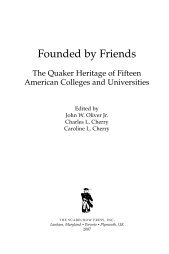Separate Realities: The Dream and the Iceberg - Scarecrow Press
Separate Realities: The Dream and the Iceberg - Scarecrow Press
Separate Realities: The Dream and the Iceberg - Scarecrow Press
Create successful ePaper yourself
Turn your PDF publications into a flip-book with our unique Google optimized e-Paper software.
66 Chapter 2<br />
by comparisons of “entry-level” wages for high school–educated workers,<br />
which indicate sharp income drops have occurred across generational lines.<br />
For example, <strong>the</strong> real entry-level hourly wage received by male high school<br />
graduates (ages nineteen to twenty-five) declined from $13.39 in 1973 to<br />
$10.93 in 2005 (wages for both years computed in 2005 dollars); female high<br />
school graduates’ entry-level hourly wage fell from $9.81 in 1973 to $9.08 in<br />
2005. 112 While some young workers (e.g., college educated) experienced<br />
modest wage gains in <strong>the</strong> 1973–2005 period, <strong>the</strong> fact remains “that entry<br />
level wages for men <strong>and</strong> women high school graduates in 2005 were still below<br />
<strong>the</strong>ir levels of 1979 or 1973.” 113<br />
Research findings showing lower wages for young U.S. workers today than<br />
was <strong>the</strong> case a generation ago should not be surprising given <strong>the</strong> massive<br />
shifts that have occurred in <strong>the</strong> U.S. occupational <strong>and</strong> wage structures over<br />
<strong>the</strong> past thirty years. For young workers, finding a “good job” is increasingly<br />
problematic, as illustrated by a recent study which found only 50 percent of<br />
young workers (ages eighteen to thirty-four) without college degrees (73 percent<br />
of all young workers) held full-time, permanent jobs. 114 Given <strong>the</strong> kinds<br />
of jobs young workers hold, wage trends among young workers, <strong>and</strong> <strong>the</strong> fact<br />
that most U.S. job growth through 2014 is projected to occur in low-wage<br />
occupations, it appears that downward intergenerational mobility is, <strong>and</strong><br />
will continue to be, a relatively common experience among young adults today<br />
<strong>and</strong> in <strong>the</strong> future. 115<br />
Class Secession<br />
America’s top tier has grown infinitely richer <strong>and</strong> more removed over <strong>the</strong><br />
past 25 years. It is not unfair to say that <strong>the</strong>y are literally living in a different<br />
country. Few among <strong>the</strong>m send <strong>the</strong>ir children to our public schools.<br />
—Senator James Webb (D-VA), Wall Street Journal, November 14, 2006<br />
As class polarization <strong>and</strong> downward mobility intensify <strong>and</strong> contribute to<br />
growing community tensions <strong>and</strong> social problems, <strong>the</strong> privileged class is increasingly<br />
distancing itself from public institutions in ways that suggest not<br />
simply more suburbanization but a kind of class secession. Of course, <strong>the</strong> very<br />
wealthy have always separated <strong>the</strong>mselves from <strong>the</strong> nonwealthy through exclusive<br />
neighborhoods, clubs, <strong>and</strong> schools. However, what Robert Reich once<br />
termed <strong>the</strong> “secession of <strong>the</strong> successful” now combines traditional forms of<br />
physical <strong>and</strong> social separation <strong>and</strong> increasing numbers of privately provided<br />
services with <strong>the</strong> ideology of neoliberalism, an idea system of free market fundamentalism<br />
that encourages <strong>and</strong> legitimates hostility to public institutions.<br />
116 In short, class secession today involves both a separatist social identity<br />
<strong>and</strong> a conscious secessionistic mentality.<br />
One measure of <strong>the</strong> increasing physical separation of <strong>the</strong> privileged class<br />
from <strong>the</strong> working class is <strong>the</strong> growing number of home-owner associations,
















